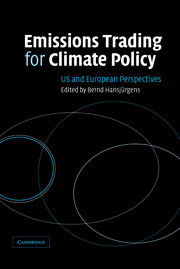Book contents
- Frontmatter
- Contents
- List of figures
- List of tables
- List of contributors
- Preface
- List of abbreviations
- 1 Introduction
- Part 1 Regulatory instruments for climate policy: theoretical aspects
- Part 2 The US approach to pollution control: lessons for climate policy
- Part 3 European policies to control greenhouse gases: the EU directive on emissions trading
- 9 Regulation or coordination: European climate policy between Scylla and Charybdis
- 10 Lobbying and CO2 trade in the EU
- 11 Greenhouse gas emissions trading in the EU: building the world's largest cap-and-trade scheme
- 12 Legal aspects of the European Emissions Trading Scheme
- 13 Emissions trading schemes in Europe: linking the EU Emissions Trading Scheme with national programs
- 14 Concluding observations
- Index
- References
9 - Regulation or coordination: European climate policy between Scylla and Charybdis
Published online by Cambridge University Press: 22 September 2009
- Frontmatter
- Contents
- List of figures
- List of tables
- List of contributors
- Preface
- List of abbreviations
- 1 Introduction
- Part 1 Regulatory instruments for climate policy: theoretical aspects
- Part 2 The US approach to pollution control: lessons for climate policy
- Part 3 European policies to control greenhouse gases: the EU directive on emissions trading
- 9 Regulation or coordination: European climate policy between Scylla and Charybdis
- 10 Lobbying and CO2 trade in the EU
- 11 Greenhouse gas emissions trading in the EU: building the world's largest cap-and-trade scheme
- 12 Legal aspects of the European Emissions Trading Scheme
- 13 Emissions trading schemes in Europe: linking the EU Emissions Trading Scheme with national programs
- 14 Concluding observations
- Index
- References
Summary
Introduction
One might have expected deliberations toward a European climate policy to have passed the stage of infancy long ago. It was in 1986 that the European Parliament passed its first resolution calling for measures to counteract the rising concentrations of carbon dioxide in the atmosphere (European Parliament, 1986). With the recent signing of the Kyoto Protocol, European climate policy deliberations have become encapsulated in a global framework, but despite widely celebrated European leadership in this process, “internal” EU climate policy has scarcely matured to the level one would expect from an eighteen-year-long policy process. The stabilization target agreed in 1990 for CO2 emissions has been exchanged for a more complex and demanding 8 percent reduction target for six greenhouse gases, but the policies and measures required to accomplish the desired reductions remain fragmented and incoherent. That the European Union succeeded in achieving a stabilization of greenhouse gas emissions from 1990 to 2000 was largely due to the combination of industrial restructuring in the former GDR and a phase-out of coal in the UK. Both the European Environment Agency and the International Energy Agency now warn that the temporary relief provided by these gratis effects is likely to be swallowed by substantial emission increases in most member states in the coming decade. The foreseen increases seem to reflect a lack of ability on the part of the European Union to develop a viable and effective climate policy on an internal basis.
This chapter addresses “domestic” European climate policy.
- Type
- Chapter
- Information
- Emissions Trading for Climate PolicyUS and European Perspectives, pp. 135 - 149Publisher: Cambridge University PressPrint publication year: 2005
References
- 8
- Cited by



